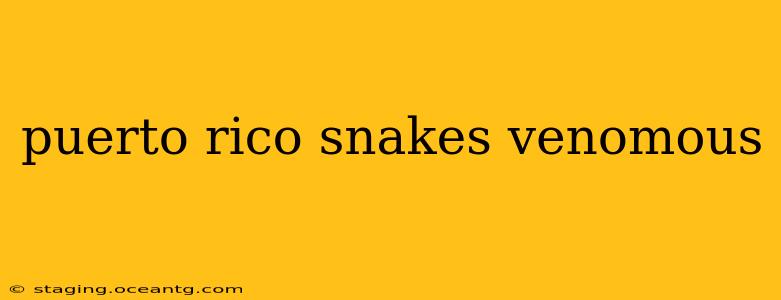Puerto Rico boasts a diverse ecosystem, but fear of venomous snakes is a common concern for both residents and visitors. While the island's snake population isn't as extensive as some mainland regions, understanding which species are venomous and how to avoid them is crucial for safety. This article will explore the venomous snakes found in Puerto Rico, discuss their characteristics, and offer valuable safety tips.
What venomous snakes are found in Puerto Rico?
The only venomous snake native to Puerto Rico is the Puerto Rican boa ( Chilabothrus inornatus). While technically a boa constrictor, and not a viper or elapid like many venomous snakes, the Puerto Rican boa possesses mildly venomous saliva. This venom is primarily used to subdue prey, and its impact on humans is generally minimal, though bites can cause localized pain, swelling, and potentially infection if not properly cleaned. It's important to note that the Puerto Rican boa is not considered aggressively venomous, and bites are rare.
Importantly, there are no other truly venomous snake species native to Puerto Rico. Any other reports should be treated with skepticism and possibly attributed to misidentification or introduced species.
Are there other venomous snakes in Puerto Rico besides the boa?
No, there are no other native venomous snakes in Puerto Rico besides the Puerto Rican boa. It's possible to encounter other species, but these are typically non-venomous. Misidentifications occur, fueled by fear and limited knowledge of the local fauna. Sticking to well-traveled paths and exercising caution in areas with dense vegetation minimizes the risk of encountering any snake, venomous or otherwise.
How dangerous is the Puerto Rican boa's venom to humans?
The Puerto Rican boa's venom isn't considered medically significant to humans. While its saliva contains mild venom to subdue its prey, it doesn't pose a substantial threat to human life. Bites are uncommon, and most often occur when the snake is threatened or feels cornered. The primary concern with a bite would be the risk of secondary infection if proper cleaning and medical attention are not sought. Symptoms are typically limited to localized pain, swelling, and minor discomfort.
What should I do if I encounter a snake in Puerto Rico?
The best approach to encountering any snake in Puerto Rico, including the Puerto Rican boa, is to avoid contact. Give the snake ample space to retreat, and never try to handle or provoke it. If you feel threatened, slowly and calmly back away. Do not attempt to kill the snake, as they play a vital role in the ecosystem.
If bitten, clean the wound thoroughly with soap and water, seek medical attention, and inform the doctor about the possible involvement of a snake. While the likelihood of severe complications from a Puerto Rican boa bite is low, professional medical attention is always advisable.
What are the characteristics of the Puerto Rican boa?
The Puerto Rican boa is a relatively large snake, typically ranging from 4 to 8 feet in length, though some exceptionally large individuals may be found. They are mostly nocturnal and are typically found in forested areas, near water sources, and in caves. Their coloration ranges from light brown to dark brown or even black, with a slightly darker dorsal pattern. They are relatively stout bodied snakes with a broad head, a characteristic that helps to distinguish them from other snakes.
How common are snake bites in Puerto Rico?
Snake bites in Puerto Rico are extremely rare. The island's snake population isn't dense, and the Puerto Rican boa is not an aggressive species. Most instances of reported "snake bites" may be misidentified or involve non-venomous species.
By understanding the local fauna and adopting a cautious approach while enjoying the natural beauty of Puerto Rico, the chances of encountering any snake, let alone suffering a bite, are significantly reduced. Remember, respect for wildlife is crucial for ensuring both human safety and ecological balance.
